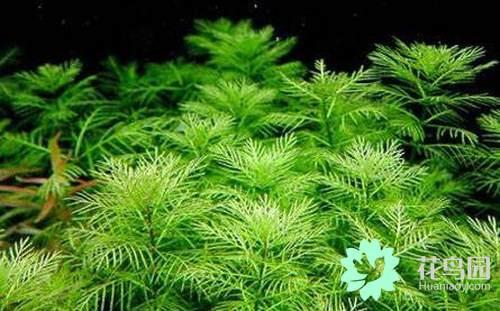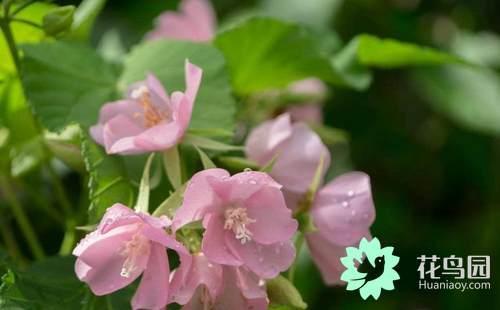The aquatic plants are also beautiful, but few people know.

Feather grass
MYRIOPHYLLUM AQUATICUM
Difficulty: medium
Lighting requirements: medium
Plant species: stemmed
Species: Formicidae
Region: central and South America, mainland China and * * are also distributed.
Size: 125px-250px
Growth rate: green is fast, red is slow.
Do you need to add CO2:YES?
Native to Latin America, it is an amphibious plant belonging to the family Erbiaceae (Formicaceae). It is also known as hydrophila, macroalga, green fox tail or feather grass. The red one is also known as Red Thousand layers. Its leaves look like the tail of a fox. The leaves are pinnately compound, with five to seven whorls. Submerged leaves are filamentous, green, scarlet and pink-green. The stem is a hollow herbaceous stem that can grow creeping or erect and branched. Older stems, which grow roots at the nodes, can be cut off and planted. Planted in groups in the aquarium is very beautiful.
Red umbrella
PROSERPINACA PALUSTRIS
Difficulty: medium
Lighting requirements: medium-high
Plant species: stemmed
Species and genera: Erxianaceae
Region: America
Size: leaf width 3-125px
Growth rate: general
Do you need to add CO2:Yes?
Dicotyledonous plant, aquatic plant. Aquatic grass is different from aquatic grass. Aquatic grass has lanceolate alternate leaves, the leaf margin is serrated, the leaf color is emerald green, it is easy to blossom and form seeds in the leaf axils, and can survive the winter as an underground stem. When cultivated in water, there will be many different changes. Including the leaf shape can change from lanceolate to ovate, irregularly lobed leaves, and even pinnate leaves and so on. The color can change from green to orange-red to crimson. There are not many red water plants with serrated leaves, among which red umbrella is the most classic. When there is a lack of iron and trace elements, the leaf color will become emerald green. At the same time, it varies according to different cultivation conditions. Its ever-changing shape is quite prominent compared with other aquatic plants. It is known as swamp mermaid in the United States and is the new favorite of aquatic plants. Prefer strong light and lower water temperature, and grow slowly in water. It is not easy to branch, usually a single stem stands and grows, and several trees can be planted together to form clusters. If you want to grow beautifully, you must import enough carbon dioxide and use liquid fertilizer of better quality in order to achieve the goal easily.
Tian Zi Cao
Scientific name: Marsilea quadrifolia Linn
Division: Marsileaceae
Distribution: station. Bay and Chinese mainland, Japan
Illumination: 1000 Lux
Water temperature: 15-28 ℃
Position: foreground and mid-view grass
Hardness: 2-10 DH
Ph value: 6.0-7.0
Degree of difficulty: average
Pteridophyte, aquatic plant. Aquatic grass is similar to aquatic grass. The aquatic grass has four green leaves, which are called "field grass" because they are arranged in the shape of the word "field". In nature, this kind of aquatic plant rarely grows aquatic leaves, usually long aquatic leaves or floating leaves. With a slender petiole, when there is less water, the petiole can lift the leaf in the air; when there is more water, the petiole is softer, making the leaf float on the water surface. At night, the leaves will fold up and droop like sleep. In winter, sporangia are produced from leaf axils, which contain sporangia and can be propagated by spores. The rhizome grows creeping on the ground and can also be reproduced by walking. It can be cultivated as foreground grass, but in low light, the petiole may extend very long, so it should be used as foreground grass setting. It can grow well under the conditions of weak acidic water quality, carbon dioxide input and normal fertilization.
Big water banyan
ANUBIAS BARTERI VAR. BARTERI
Difficulty: very easy
Lighting requirements: low
Plant species: rhizome, underground stem
Species and genera: water banyans of Araceae
Region: Africa
Size: 625px-1125px
Growth rate: slow
Do you need to add CO2:NO?
Small water banyan
Size: 125px-375px
Mini banyan
ANUBIAS BARTERI VAR. NANA * PETITE*
Size: 75px-125px
Growth rate: slow
Do you need to add CO2:NO?
It is improved from small water banyan, and the plant is smaller than small water banyan. The root should be hydrophobic, suitable for sunken wood and stone; as the growth is very slow, it is easy to provoke algae, so pay attention to the balance of light and fertilizer.
Japanese scallop
BLYXA JAPonICA
Japanese scallop
Difficulty: average
Lighting requirements: high
Plant species: with stems
Species and genera: water screen genus of Trionychidae
Region: mostly distributed in Southeast Asia, Korea, Japan, China and other places
Size: 175px-375px
Growth rate: fast
Do you need to add CO2: YES
When the aquarium is cultivated, it is often used as a mid-view chapter. At present, this plant is on the verge of extinction due to the destruction of the environment. Because this plant is difficult to manage, it is not suitable for those who lack experience.
Japanese seaweed is not strict on water quality, so it is best to cultivate it in fresh water with low hardness, and pay attention to the salinity should not be too high. The pH of water should be controlled between 5.5 and 7.5, that is, from slightly acidic to slightly alkaline. It has a great demand for fertilizer, and it can be topdressing every 2-3 weeks in the stage of vigorous growth. If there are conditions, it is best to put carbon dioxide gas into the cultivation container as fertilizer to improve the photosynthetic efficiency of the plant, and its supply rate should be kept at 2 bubbles per second. Japanese seaweed likes the place where there is plenty of light, and it can also receive 2-4 hours of scattered sunlight every day. When cultivated in an environment that lacks light, you can use special fluorescent lamps and give artificial light for 8-10 hours a day, so that the plant can grow more normally. Be careful not to make the light too strong, or the green moss will spread quickly. Under intense sunlight, the tip of the leaf turns reddish brown.
Newton
DIDIPLIS DIANDRA
Difficulty: higher
Lighting requirements: high (but avoid extremely high)
Plant species: with stems
Species and genera: Chimonidae
Region: southern North America, Mexico (in fact, China also has)
Size: 50px-100px
Its origin is in North America, its growth needs strong light, the temperature is generally between 22 and 25 degrees, PH is between 6.8 and 7.2, carbon dioxide needs to be added when planting, when it grows better, it is generally between 20--30CM. The leaves of Newton grass are small, opposite and the stem nodes are short. The difficulty of its cultivation is that it is very sensitive to the changes of light and PH. The light source is preferably warm, and the light is enhanced. The top of the Newtonian grass turns red because it is close to the light. After the lateral buds protrude from the underground stem, they can form dense clusters, similar to mousse.
Newton grass is a very characteristic aquatic plant, but it is difficult to grow, and it is the middle backdrop grass in the grass jar. But if it is a good kind of grass, it is a very attractive grass species.
Wave pepper grass
Cryptocoryne undulata
Wave pepper grass comes from Sri Lanka, with a growth height of about 10-15CM and a leaf width of about 10CM. It is a common beautiful aquatic plant cultivated in an aquarium. The edge of the leaf blade is wavy and dark red with twill. When there is not enough light, the leaves will be green and the underground stem will stretch vertically, "teeth and claws" in the water. So the illuminance needs to be enough to let its crimson leaves leak out. Like old water and stable water quality. If the water quality, lighting or water temperature changes sharply in a short period of time, the leaves are easy to rot.
Green Wendy pepper grass
Cryptocoryne wendtii * green*
Belongs to the quite adaptable aquatic plant, the petiole is brown or red. In the aquarium, the leaves will become long and narrow, about 12-15CM, emerald green. Due to the influence of water quality and light, the leaves changed from bright green to reddish brown. [note: different data have different opinions. It is said that "green Wendy pepper grass will not turn brown or brown under any water quality conditions". Green Wendy pepper grass is an easy-to-grow aquatic grass, preferring a substrate with sufficient fertilizer (such as a muddy bed), but too much iron will make the leaves wither and fall, and too much CO2 will also lead to grass softening.
There is also a pepper grass called Cryptocoryne wendtii * green gecko* on foreign websites, which is directly translated as "green gecko Wendy pepper grass". I don't know if it is a new species or a variety or special species of our common green pepper grass.
Red Wendi pepper grass / red pepper grass
Cryptocoryne wendtii * mi oya* / Cryptocoryne wendtii * red*
In fact, what is generally called Wendy pepper grass on the market refers to red Wendy pepper grass, that is to say, Cryptocoryne wendtii refers to red Wendy pepper grass, which is distributed in Sri Lanka, with lanceolate leaves, 10-15 cm long and 2-3 cm wide. Its aquatic leaves are of the same type as those in the water, which do not look like red, but they are a little brownish green or reddish green, but the back of the leaves is light green and red, because they are adaptable in the water. So it is widely used in the ecological tank of aquatic plants. Relatively speaking, green Wendy pepper grass is easier to grow than red Wendy, which is easy to wither if it is taken care of improperly, and it has a special preference for calcium content in water quality.
- Prev

The cast of the movie "Wolf Warriors 3" may be confirmed in addition to Andy Lau and Zhao Wenzhuo.
Friends who have seen the first two films of Wolf Warriors, are they looking forward to Wolf Warriors 3 very much? Due to the basic confirmation of the main co-actors of "Wolf Warriors 3" recently, everyone's expectations can be said to be just around the corner. Before, it was held by Wu Jing.
- Next

It is easy to master these skills to raise African hibiscus.
African hibiscus is loved by people for its beautiful and colorful hanging bouquets, which can be seen more or less in courtyards, parks, neighborhoods and campuses. Their maintenance conditions are not too complicated, and they can be raised simply.
Related
- Wuhan Hospital Iron Tree Blooming Result Was Instantly Frightened by the Gardener Master
- Which variety of camellia is the most fragrant and best? Which one do you like best?
- What is the small blue coat, the breeding methods and matters needing attention of the succulent plant
- Dormancy time and maintenance management of succulent plants during dormancy
- Minas succulent how to raise, Minas succulent plant pictures
- What are the varieties of winter succulent plants
- How to raise succulent plants in twelve rolls? let's take a look at some experience of breeding twelve rolls.
- Attention should be paid to water control for succulent plants during dormant period (winter and summer)
- Watering experience of twelve rolls of succulent plants
- Techniques for fertilizing succulent plants. An article will let you know how to fertilize succulent plants.

